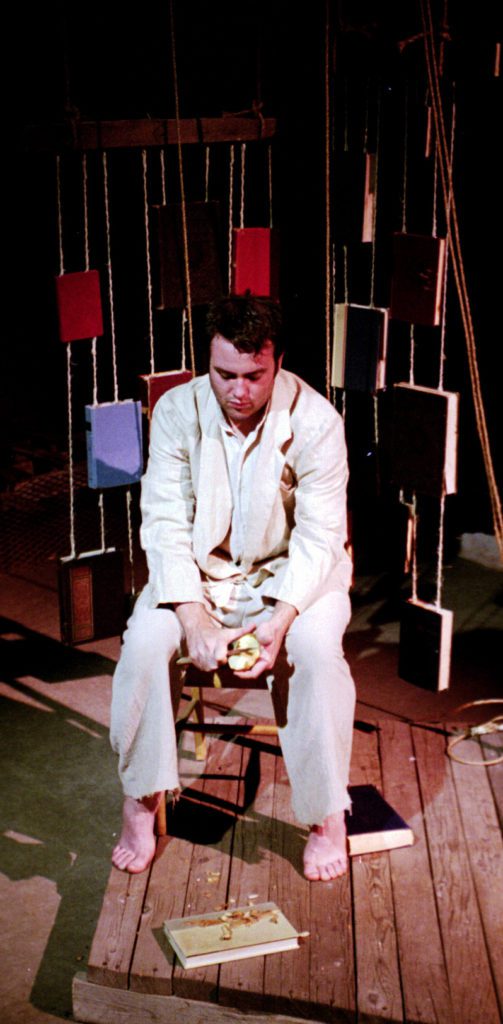Aw … isn’t it cute? Look at those fingers, look at those wiggly little toes! And that … claw … and my, look at that big tail! There’s a new member of Denver’s theatre family and the relatives are going to be really proud of this one all right. Bouncing baby Buntport arrived at the Phoenix March 15, and the fact that it has six heads is a good thing, folks. Really it is. You see, as emerging theatre companies go, six stable, gifted, collaborative artists is more than enough. Especially when they write their own material and throw all known boundaries and paradigms aside.
They played to a large house at the Phoenix, and although that in itself is good news, the better news is that Buntport has just leased permanent space. The group is in the process of creating a black box stage that will be opening soon.
The sooner the better, I might add. Buntport stages original creations, thematically rooted in literary classics. The work, though, is stretched so far beyond the veil of the canon as to give rise to something completely different, yet recognizable–and glitteringly funny.
2 in 1 pits James Thurber against … that unknown guy or priest or, well, whoever wrote Beowulf. During the first act (nine quickies based on Thurber short stories), I was convinced Thurber was going to win the day. I mean we are talking Thurber here, and Act I does start out with two men and two women in bed and all. The audience was laughing right off the bat– that’s the first story, see– “Mr. Monroe vs. The Bat.” Well, anyway, by the time the bat bit was done, all the finite details of the piece came winging through the theatre. And even though Thurber was one of the finest word surgeons ever, Buntport had sewn in enough comedy to keep the audience in stitches.
The entire retinue of nine scenes was outstanding, both literarily and comically speaking. Act I managed to promote a profound appreciation for Thurber’s work and words, while at the same time, spotlighting Buntport’s creatively comic ever-sharpening edge. Highlights, in fact, were many. But particularly impressive was the dual tandem acting scene in “Helpful Hints and the Hoveys.” The absolute knock-out bit of Act I, though, was “The Evening’s at Seven,” a play in which only one phrase is uttered on stage, but which is an enchantingly poignant, expertly executed piece of experimental theater. The piece is not so overcast and dark as to make the mood heavy, but provides a perfect dose of dramatic relief.
And then there’s Act II, “Word-Horde,” a dramatization of the study guide to Beowulf. Now, even though I’d pit Thurber’s brains against Beowulf’s brawn any day, I gotta tell you, the big dummy won the stage, though more to the credit of the Buntport group than the work. Hand-woven paper claws, fantastic timing and dialogue, and nifty movement between the reenactment and the CliffsNotes team had the audience entirely jovial and begging for more, to the degree that when the evening finally ended, no one would leave. That’s right, we witnessed a play about Beowulf, and we so much wanted more that we clung to our seats for a while when it was over. I’ve actually read Beowulf folks, and all I can tell you is that it’s not the kind of read you go in for a second time. To have a staged event based upon Beowulf which leaves the audience practically crying for more is nothing short of miraculous.
Now, I’m a big fan of comedy, but often I find it artistically lacking. Not so with 2 in 1. The Buntport team understands subtle nuance, timing, background setting and set design. They also understand when to break scenes, when to cull the laughter and when to turn it on. And, best of all they understand dramatic action. This, friends means that Buntport is presenting not just comedy, but High Comedy. You know, something along the lines of Shakespeare’s comedies, complete with wit, charm, laughs, intelligence, rhythm, discernible meter, fully developed characters and so on. Additionally, the work is experimental and fresh as a crocus in February, making for great theatre and even better comedy.
-Cilicia Yakhlef, March 29 – April 11, 2001, Go-Go Magazine







